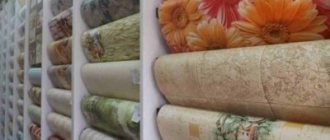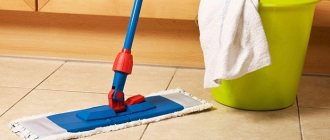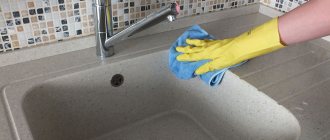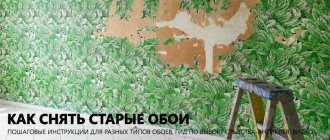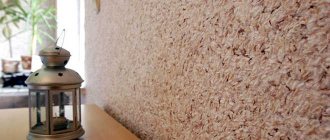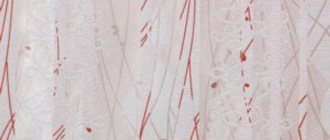The modern market offers a huge selection of wall coverings, among which wallpaper occupies a special place. There are many types of them, and it is very important to properly care for such a finish, regardless of whether it is moisture resistant or not.
Let's take a closer look at whether non-woven wallpaper and other types of these materials can be washed, and whether cleaning will spoil their surface.
How to wash non-woven vinyl wallpaper
These coatings have many advantages compared to paper and some others. They are not only easy to glue, but can also be washed and painted several times. But not everyone knows how to properly wash non-woven wallpaper so as not to damage its texture and pattern.
Folk remedies
Citric acid is used to clean this coating. For this you need 3 tbsp. Dilute spoons of powder in 200 ml of water (warm), moisten a soft cloth with the solution and apply it to the wall. Wait 3-5 minutes, repeat the procedure to remove dirt and dry the surface.
Purchased funds
Let's consider the general algorithm of actions when cleaning walls using household chemicals.
Required:
- cloth or sponge;
- water in a basin or other container;
- detergent (for example, dishwashing detergent or any other preparation).
The wallpaper cleaning process is quick and easy. To work, you just need to prepare the necessary materials.
Important: do not dry washable wallpaper with a hairdryer or by airing. This will not only not speed up the drying process, but can also ruin the wall coating.
- Prepare a solution of detergent and water in a ratio of 1 tsp. per liter respectively.
- Dip a sponge or cloth into the resulting mixture and squeeze it out.
- Clean the wallpaper from top to bottom.
- Wipe the washed areas with a dry sponge, cloth or brush and leave to dry.
Basic rules for cleaning wallpaper
Before cleaning, you need to find out what type of wallpaper it is, what material it is made of and whether it can be washed with water. All this information is usually indicated on the packaging.
So, what types of canvases are there:
- waterproof wallpaper, which can be gently wiped with a damp cloth;
- washable wallpaper - they can be cleaned with soap or some other cleaning solution;
- super-resistant to water use - which means you can use absolutely any cleaning products;
- super resistant to cleaning and friction - you don’t have to worry about such wallpaper, it will withstand everything.
All this information is usually indicated on the packaging in the form of pictures and inscriptions. If the label is not preserved, you can find similar wallpaper in the store and check with a consultant for cleaning conditions. Or try the cleaning agent on an inconspicuous area of the fabric and draw the appropriate conclusions.
How to wash paper-based vinyl wallpaper
Let's consider whether wallpaper with a paper base can be washed.
Folk remedies
Such coatings can be easily cleaned with laundry soap. To do this, just prepare a solution. It should be done in a ratio of 1:10 in relation to detergent to water. You need to carefully apply the composition to the wall using a rag, then you need to rinse it, wring it out and remove any remaining soap from the treated area.
Purchased funds
Paper-based vinyl wallpaper can only be wiped with a damp cloth and detergent. If the contamination is strong, it is allowed to wash the coverings, but do it very quickly, in the same way as non-woven ones.
How to remove glue from wallpaper
It seemed like the renovation would take forever! But now, the last thorough repair work has been carried out, the floors have been finished, wallpaper has been hung, and - bad luck: in some places traces of dried glue are clearly visible. What to do? Is it really necessary to start all over again? Fortunately, no! In this article we will talk in detail about how to independently remove adhesive stains from the surface of wallpaper without damaging it at all.
Removing glue stains from wallpaper: how to do it correctly
As practice shows, it is almost impossible to remove dried glue from wallpaper without damage. However, if you have non-woven wallpaper, which is characterized by extreme resistance to external negative factors (including all kinds of mechanical damage), you can try to do this without the risk of damaging their appearance. To begin, arm yourself with a regular foam sponge soaked in water - perhaps the adhesive composition will succumb to such a minor impact. Use it to treat a separate cut piece of wallpaper - if it doesn’t get wet, then feel free to proceed with further manipulations with the contaminated area.
Additionally, let's take into account the fact that some types of wallpaper are pre-designed for washing according to the manufacturer's plans (this is indicated on their packaging using a marker in the form of three wavy lines). Therefore, you can, without a twinge of conscience, try to remove the stain with a soap solution.
If we are not talking about expensive professional adhesive mixtures, but about homemade glue, cleaning the wallpaper from its residue will not be difficult. In particular, glue based on modified starch can be dealt with quite easily using improvised means.
How to remove grease from washable trim
Grease stains, splashes, and fingerprints can be washed off in several ways. To do this you will need readily available materials.
Important: any wallpaper must be washed very quickly so that it does not get damaged or come off the wall.
Grease stains appear more often in the kitchen. They are most easily removed with baby powder. This is done as follows:
- Sprinkle a sponge or rag with talcum powder.
- They wipe the wall. Leave for 10 minutes.
- Remove the powder with a dry cloth.
There is another way to remove grease stains. It involves using an iron and paper towel.
- Place a napkin over the stained area.
- Carefully iron this area with an iron.
Why does wallpaper get dirty?
Despite its practicality, vinyl wallpaper gets dirty over time.
Vinyl is a foam material fixed with inbrids that is soft and pleasant to the touch. This finish is durable and practical, suitable for renovation in rooms with high humidity. If you wish, you can update the interior and change the color of the walls by painting. Sometimes it is enough to simply wash them to restore freshness and remove dirt that appears in the most visible areas.
The most common reasons why wallpaper gets dirty:
- Seam wear . At the joints, several years after gluing, the edges lose their plasticity, the seams separate, bend, and dust and dirt get clogged there.
- Porous structure . The surface of the wallpaper is uneven, so dust microparticles gradually accumulate in the pores, which is why the canvas takes on an earthy color.
- Food stains . Appear as a result of careless handling of food and drinks.
- Hand marks . Walking around the room, household members touch the walls and stain them.
Pollution can also be caused by children's pastimes - kids paint the walls with felt-tip pens, pencils or “unloved porridge”. These stains are difficult to clean without damaging the finish.
How to clean markers and ink from walls
If such “art” decorates your room, don’t be upset. These stains can be washed out from wallpaper that is not silkscreen or paper.
In addition, pay attention to the type of markers: if they are alcohol-based, the drawing can be easily erased with alcohol or vinegar, rubbing the liquid into the stain with a cotton pad. It is much easier with water-based markers; they are washed off with plain soapy water.
Fingerprints can be removed using an eraser. To do this, just rub the stain with a little force.
Caring for wallpaper after washing
Wallpaper does not require frequent cleaning. Even if they are washable, you shouldn't wash them regularly. This is done as soon as it becomes dirty or visible stains form. After completing such cleaning, the wallpaper must be dried thoroughly. It is better to do this in a ventilated area to prevent mold. But there is no need to use a hairdryer for drying, which can cause the canvas to peel off.
It is important when purchasing wallpaper to take into account the characteristics of the room in which it will be glued.
How to wash before painting
If the wallpaper is to be painted, it must first be degreased and free of dust.
You can simply use a vacuum cleaner or steam cleaner for light cleaning, but if the dirt is more serious than dust, you need to wash the wallpaper. This is done as follows:
- We wipe the wall covering with a cloth or sponge soaked in soapy water.
- We wipe the area with a dry cloth or soft washcloth.
- Let the wall dry. You need to let it dry completely, but without a hairdryer or draft. After this, it will be possible to produce high-quality painting.
Advantages and disadvantages
Such wallpaper is relatively new on the market, but this time was enough to appreciate all the advantages of non-woven wallpaper:
- maintaining dimensions after drying;
- increased density of the canvas, allowing you to hide cracks and unevenness on the wall;
- resistance to fire, smoldering and high temperatures;
- oxygen transmission;
- water resistance;
- maintainability;
- possibility of painting.
Separately, it should be noted such features of non-woven wallpaper as ease of gluing and leveling. When using non-woven wallpaper, glue must be applied only to the wall. This helps preserve the quality of the flooring, time and effort spent on repairs. Wallpaper can also be removed easily. Before removing non-woven wallpaper, you do not need to carry out any preparatory measures.
Non-woven wallpaper also has disadvantages:
- low resistance to dirt due to the porous structure and ability to collect dust;
- high cost relative to other types of wallpaper.
It is worth noting that these disadvantages are very insignificant relative to the advantages, which makes any non-woven wallpaper the most popular material for interior decoration. And if you know how to glue meter-long non-woven wallpaper, then soon the room will sparkle with new colors.
How to make your own hand wash
In addition to detergent and soap, baking soda is great for cleaning wall coverings. This solution can be prepared at home and from scrap materials. This folk method is based on soda.
What is needed for the solution
- soda - 40 g;
- warm water - 2 l.
How to clean a wall with baking soda
- Combine the powder with water. Mix thoroughly until smooth.
- Dip the sponge into the solution and carefully wipe the wall with it.
Important: baking soda will help get rid of not only dirt and grease, but also unpleasant odors. With special effort, you can even wipe away soot, plaque, and mold.
Methods for washing wallpaper
So, we figured out the types of washable wallpaper. Now let's look at how to wash wallpaper at home. There are quite a lot of different folk remedies, however, the truly effective ones are the following:
Traditional methods of cleaning wallpaper
Next, we will consider in detail each of these methods of cleaning wallpaper.
Baking soda
Method 1: Baking soda solution
The simplest solution for cleaning wallpaper is a solution of baking soda. The instructions for its use are extremely simple:
- baking soda should be mixed with warm clean water in the proportion of 20 g of soda per 1 liter of water;
- Next, you need to prepare a clean, soft rag or sponge;
- then soak the sponge in water, wring it out, and wipe the dirty areas with it.
This method is quite universal, as it helps to get rid of various deposits that often appear on linens in the kitchen.
Soapy water is the most common wallpaper cleaner.
Method 2: soapy water
Another simple and quite effective means of cleaning the surface from various types of contaminants is a soap solution. In this case, the work is carried out like this:
- prepare a soap solution in a ratio of 1:10;
- then you need to dip a sponge into the solution and rub the contaminated area with it;
- After removing the dirt, the sponge should be rinsed in clean water and wiped over the surface of the wallpaper to remove the soap solution.
I must say that with this method you can erase marks from felt-tip pens, pencils and some other stains. True, both soap and soda solutions are effective only if the dirt is not deeply ingrained into the coating .
To avoid the hassle of removing stains that have become embedded in the surface, try to get rid of them immediately after they appear.
Before use, talc must be poured onto a sponge.
Method 3: cleaning with talcum powder
If you need to clean the surface of grease, use talcum powder. Work with this tool is carried out in the following sequence:
- Cover the surfaces around the contaminated area with oilcloth or newspapers. This is necessary so as not to cover everything around with talcum powder;
- Next, pour the powder into a sponge and treat the greasy stains with it;
- let the surfaces sit for 10-15 minutes;
- then remove the talc using a dry sponge;
- If you are unable to completely get rid of the greasy marks the first time, treat the surface again with talcum powder and gently heat the contaminated area with an iron through a cloth.
Bread will help get rid of grease stains
There is another popular way to remove fat. Its essence lies in the fact that the contaminated area is rubbed with bread crumb. The gluten contained in its composition removes this kind of contamination well.
Lemon acid
Method 4: citric acid
Various plaques, including greasy ones, are well removed by citric acid. It should be used as follows:
- Add a few tablespoons of citric acid to a glass of warm water;
- then moisten the sponge in a solution of citric acid and treat the contaminated area with it;
- the treated area should be left for five minutes;
- then the contaminated surface should be lightly rubbed with a sponge soaked in citric acid;
- After cleaning the contaminated area, it should be wiped with a sponge soaked in clean water to remove citric acid.
It should be noted that this method washes off the alcohol marker well, which can be used by little art lovers to stain the walls.
Marks from felt-tip pens can be removed with alcohol.
Method 5: alcohol
If you don’t know how to clean stubborn grease stains, or traces of felt-tip pens and markers, splashes of food prepared in the kitchen, etc., use alcohol. This cleaning method is quite simple and quick:
- moisten a cotton swab with alcohol;
- Immediately wipe the stained area with it before the alcohol evaporates.
It must be said that this method also easily removes sticker marks, mosquito stains and other similar aerosol products.
Dish detergent will help clean wallpaper from various contaminants.
Method 6: Dish detergent
If your wallpaper can withstand detergents, you can use dishwashing detergent to remove grease and other contaminants. Working with it is carried out as follows:
- add a few drops of detergent per liter of warm water;
- moisten the sponge in the resulting solution and treat the contaminated area with it;
- After some time, wipe the area with a sponge soaked in clean water to remove the cleaning solution.
This method allows you to combat dirt more effectively than a regular soap solution.
In the photo - a solution of hydrochloric acid
Method 7: hydrochloric acid
People often ask on forums how to remove brilliant green? This type of contamination is most effectively dealt with by hydrochloric acid . It is applied as follows:
- take a three to five percent solution of hydrochloric acid;
- moisten a sponge or rag with acid and wipe the area of wallpaper contaminated with brilliant green with it;
- To finish the job, wipe the surface with a sponge soaked in clean water.
If mold appears on the surface of the wallpaper, it can be removed with whitewash. After this, mold will not appear on wallpaper treated with chlorine for a long time.
Hydrogen peroxide will help get rid of blood stains on wallpaper
Method 8: hydrogen peroxide
If you need to remove blood from a finish, use hydrogen peroxide. The surface cleaning process is very simple:
- soak a cotton swab in hydrogen peroxide;
- Wipe off the blood with a swab. At the same time, change sides of the tampon so as not to stain clean areas with blood;
- then wipe the surface with a damp sponge or cloth.
Method 9: Vinegar
Sometimes it becomes necessary to clean wallpaper from glue remaining after careless gluing. I’ll say right away that it’s not always possible to get rid of glue, since some types of glue cannot be removed by anything after drying. However, sometimes ordinary table vinegar helps get rid of such contamination.
Vinegar should be applied using a spray bottle.
The cleaning process in this case looks like this:
- pour nine percent vinegar into a spray bottle;
- then moisten the contaminated area with vinegar;
- After 10-15 minutes, the area treated with vinegar should be wiped with a damp sponge or rag.
If the glue is fresh, i.e. If it has only dried slightly, you can use regular warm water to remove it.
Here, in fact, are all the ways to clean wallpaper from various contaminants with your own hands, which I wanted to share with you.
Do not press the sponge or rag too hard against the wallpaper during cleaning.
What to do if there is no marking
There are special signs on the wallpaper. They show how the coating reacts to water and other external factors. For example, a marking with one wave means that the material can only be wiped with a damp cloth, with two such icons - you can use some detergents, with three - the wallpaper is very resistant to water and can be safely washed. And the sign with waves and a brush means that you can use a washing vacuum cleaner and other cleaning products.
But how do you know if non-woven vinyl wallpaper can be washed if there is no marking? If there are no signs, just check the reaction of the wallpaper to moisture in an inconspicuous place. To do this, just select a small corner of the coating and wash it in one of the following ways: if it is not damaged, you can continue working with the entire wall.
We looked at the main ways to properly wash wallpaper. This task is not so difficult if you follow all the recommendations in the article and video, and also avoid heavy contamination. You can use both purchased products and traditional cleaning methods for this procedure - your walls with a stylish coating will retain their fresh, original appearance for a long time!
Tips and tricks
Before you start washing, you need to clarify what type of wallpaper you have. To verify this, just look at the markings on the canvas. Only then do we choose the appropriate washing method.
Although the material can withstand moisture and cleaning, do not use hard or rough brushes or use brute force.
Before starting the procedure, carry out a test cleaning in the least visible places to make sure that the chosen method is correct.

